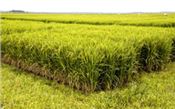|
Rice Acreage May Cushion Economic Impacts Of COVID On Arkansas Farms

Improved rice varieties like ARoma 17, Wells and others are developed and tested in research plots at the University
of Arkansas System Division of Agriculture’s Rice Research and Extension Center.
Division of Agriculture photo by Fred Miller
FAYETTEVILLE, ARK.
Growing rice may provide some insulation from the economic impacts of COVID-19 for Arkansas farms, but cotton growers are likely to be harder hit through 2023, according to a model run by the University of Arkansas System Division of Agriculture.
The study did have an upside: the negative effects from COVID-19 on 2019 commodity prices will likely be offset by payments from the Coronavirus Food Assistance program, or CFAP. Since program enrollment began in late May, Arkansas ag producers have received more than $93 million in direct payments through CFAP. Of the total, major row crops – non-specialty crops – account for just over $22 million in payments. Enrolment for the CFAP program ends Aug. 28.
The study is by Alvaro Durand-Morat, Scott Stiles, Brad Watkins and Bob Stark, all agricultural economists with the Division of Agriculture. Their work is drawn from a five-farm model based on financial data files made available by the Texas A&M Agricultural and Food Policy Center developed with the assistance of the Arkansas Cooperative Extension Service.
The five representative farms are based on local conditions at Wynne, Stuttgart, Hoxie, McGehee, and Mississippi County. The farms have various combinations of long- and medium-grain rice, soybeans, corn cotton and peanuts. The models include the safety net programs under the 2018 Farm Bill, in particular, the Price Loss Coverage and Agricultural Risk Coverage-County programs. The authors also assume that all rice, corn, cotton, and peanut acres are enrolled in PLC, while all soybean acres are enrolled in ARC-CO for the duration of the 2018 Farm Bill.
The economists looked at the 2019 to 2023 marketing years.
“COVID-19 has affected commodity prices globally by disrupting the supply and demand of agricultural commodities in unprecedented ways,” Durand-Moat said.
Lower revenues
“All five farms will receive lower revenues and have lower net cash farm incomes due to COVID-19 in every marketing year considered in the projection,” Durand-Morat said.
“Corn, at minus 14.3 percent, and cotton, at minus 13.7 percent, would experience the largest decreases in prices in the short term,” he said. The plus side is that “as a result of COVID-19, the price of long-grain rice in the U.S. is projected to increase by 4.8 percent and 3.3 percent in 2020 and 2021, and decrease below the baseline thereafter, while the price of medium-grain rice in the U.S. increases slightly in 2020 and 2021, and decreases slightly thereafter.”
“The loss of net cash farm income of Arkansas representative farms, 2019–2023 during COVID-19, are lower in the Wynne, Hoxie, Stuttgart farms since they have a large share of rice acres,” Durand-Morat said.
“The Coronavirus Food Assistance Program payments issued for the 2019 corn, soybean, and cotton crops effectively compensate for the 2019 revenue loss due to COVID-19 for the five farms in the model,” he said.
The Food and Agricultural Policy Research Institute projects that all commodities will realize lower prices due to COVID-19 compared to the baseline for the coming years.
Find the study here: https://agcomm.uark.edu/agnews/publications/1002_Impact_COVID-19_Ark_Field_Crop_Farms_2020.pdf ∆
|
|